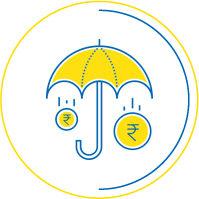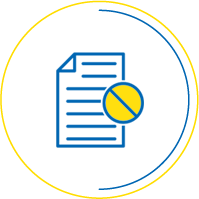new list item only visible in amp & mobile view & desktop

- 24800+CASHLESS HEALTHCARE PROVIDERS^^
- 48 Lakh+INSURANCE CLAIMS SETTLED*
- 24*7CLAIM AND CUSTOMER SUPPORT
What is Group Personal Accident Insurance?
Group personal accident insurance safeguards employees of an organization against expenses arising due to personal accidents leading to disability or death. In an increasingly competitive business scenario, every organization needs to stay prepared for unexpected exigencies. Care Health Insurance’s group personal accidental policies are designed to empower your organization with a comprehensive personal accident insurance coverage.
Benefits of Group Personal Accident Insurance
- Accidental Death – Care Health Insurance pays the principal Sum Insured amount as per the policy schedule, in case an injury to insured member results in Loss of life. The loss must occur under the circumstances described as hazard, within 365 days from the date of Accident which caused injury. Accident here means a sudden, unforeseen and involuntary event caused by external and visible means.
- Permanent Total Disablement (PTD) – Here, compensation payable is a predetermined percentage of the Sum Insured as mentioned in the policy Certificate against Optional Extension, depending on severity of disablement.
- Permanent Partial Disablement (PPD) - Compensation payable is a predetermined percentage of the Sum Insured as mentioned in the policy Certificate against Optional Extension, depending on severity of disablement.
- Temporary Total Disablement (TTD) - Compensation payable, if the Injury suffered by the insured member immediately results in Temporary Total Disablement of the insured member during Cover Period. Then we pay the amount specified in the Policy Certificate against Optional Extension. You have the option to select Excess Period and Sublimit for this Optional Extension.
- Medical Extension - We will reimburse the Insured Member up to Sum Insured of this Optional extension as stated in the policy certificate, if he/she is hospitalized or is an outpatient in a nursing home for medical treatment required as a result of accident. You have the option to select the sublimit for this Optional Extension.
What is the Sum Insured for a Group Personal Accident (GPA) Insurance policy?
Sum Insured for each member of the Group Personal Accident (GPA) policy is mainly decided on the basis of earning capacity (Annual Salary) of each employee. As a general rule, the Sum Insured for each employee in a Group Personal Accident insurance policy can be equal to 6 times of annual CTC of the employee
Inclusions & Exclusions under Group Personal Accident Insurance
-
Inclusions
Exclusions
-

Natural Causes of Death, death arising out of an illness

Death or injury when under the influence of alcohol or drugs

Death or injury caused by dangerous adventure sports

Self-inflicted injury

Death due to suicide

Death due to childbirth or pregnancy

Venereal or sexually transmitted diseases

Death due to participation in a riot, civil commotion or criminal activity

Any act resulting in a breach of law with criminal intent
Additional coverage
- Education allowance
- Family transportation
- Modification allowance
- Repatriation of remains
- Compassionate visit
- PTD Improvement
- Ambulance services
Benefits and Key points of Group Personal Accident Insurance:-
Unfortunate accidents have a knack of throwing the financial footing of a whole family out of kilter for a long time and the number of people getting injured in accidents is staggering. Being a breadwinner of the family, even a single accident leading to hospitalisation can pose serious financial threats to an employee’s family. It is hence important to be well prepared for such a circumstance. And a Group Personal Accident Insurance Policy not only secures your employees’ health and finances but also boosts their morale to work and encourage employee retention.Key Points:-
- Secures employees against unforeseen circumstances.
- Payable if the insured dies or sustains any bodily injury resulting solely and directly from accident caused by external, violent and visible means whether due to employment or otherwise.
- Will not come into force in case of occupational diseases.
- Employer can choose the Sum Insured which can be a multiple of the salary or a graded cover according to the designation.
- GPA is a Benefit policy and not under any Act where compensations are benefits offered to the employees.
- Not payable if the employee is found under the influence of alcohol/drugs or regulation i.e. negligence.
How to Claim Group Personal Accident Insurance?
The insured must follow the below mentioned procedure to submit a claim under a group accidental insurance policy. The procedure can vary slightly in case of death settlements and injury claims
- Inform the insurer that issued the policy right away. The policy's assignee should carry out this action.
- Send the required documents like the death certificate, claim form, original policy copy, autopsy report, and police report.
Steps to follow in case of claim for injuries:
- Inform the insurance provider that issued the policy immediately.
- Send police reports (if applicable).
- Send the claim form and medical certificate attesting your disability.
- If the coverage plan contains a medical expense extension, submit the prescription and related bills.
Documents Required to Claim Group Personal Accident Insurance
While filing a claim, the insured must provide the following documents in completion and correct forms:
- Completely filled and signed claim form
- Doctor's prescription or declaration completed by the attending physician
- All genuine/original bills
- Original diagnostic reports
- Copy of the employee's and the nominee's ID
- Copy of Photo ID
- A cancelled cheque written out in the name of the employee or nominee
- Copy of the Panchnama, MLC, and/or FIR (if registered)
In the event of a temporary total impairment, the following documentation must be submitted:
- A copy of the medical records attesting to the injury or accident and the treatment received
- Reports from the investigation and X-ray images supporting the accidental injury, post-operative
- Leave documents with the authorized signatory's seal and signature
- Certified medical fitness form by the treating physician
In an event of permanent partial or whole impairment, the following documentation must be submitted:
- Certificate of disability
- Reports from the investigation and X-ray images support the accidental injury
In an event of accidental death, one must submit the following documents:
- Copies of the investigative reports, treatment records and death summary
- Death certificate copy
- Copy of the post-mortem/autopsy report
- Duplicate copy of police investigation's final report
FAQs about Group Personal Accident (GPA) Insurance
-
Q.What is Group Personal Accident (GPA) Insurance and what are its advantages?
GPA insurance is an insurance policy which provides reimbursement to the insured in case of an accidental death, permanent total disability, partial disability and temporary total disability.
-
Q.What happens in case of an accidental death?
If an employee dies due to an accident, a group personal accident policy pays 100% of Sum Insured to the employee’s family.
-
Q.What is the Total Permanent Disability?
Total Permanent Disability (TPD) is the condition in which a person cannot work due to bodily injury caused by accident. For instance, loss of limbs or vision
-
Q.What is Partial Permanent Disability?
Partial Permanent Disability means you have a partial impairment which may be caused due to an accident or injury. It means you can still function, but partially. For example, speech loss, hearing loss, back injury, etc.
-
Q.What medical examinations must I have in order to enrol for GPA?
This policy does not necessitate a medical examination.
-
Q.Can part-time workers be secured by a GPA?
Typically, only full-time employees are eligible to get coverage under a GPA policy. However, depending upon the contract terms between the insurance company and the employer, part-time or contract workers may also be covered.
-
Q.Who pays the GPA insurance premium?
In most cases, the employer pays off the premium for GPA policy. Although, in some cases employees can be asked to contribute to premium payment particularly if they choose additional benefits at individual level.
-
Q.What factors influence premium of a GPA policy?
Premium for a GPA policy is determined by factors like group size, coverage, add-ons, features/benefits and demographic factors such as age, income of employees and nature of job.